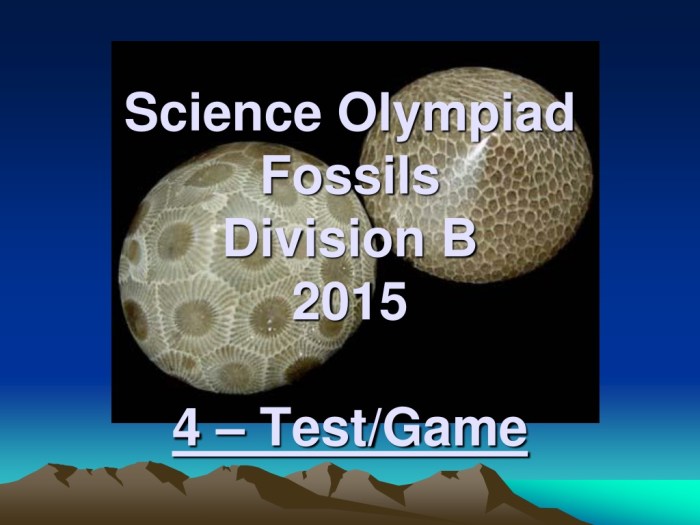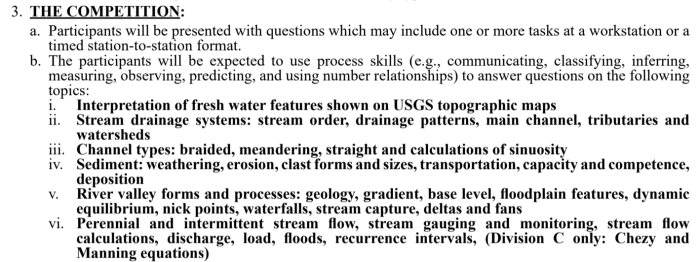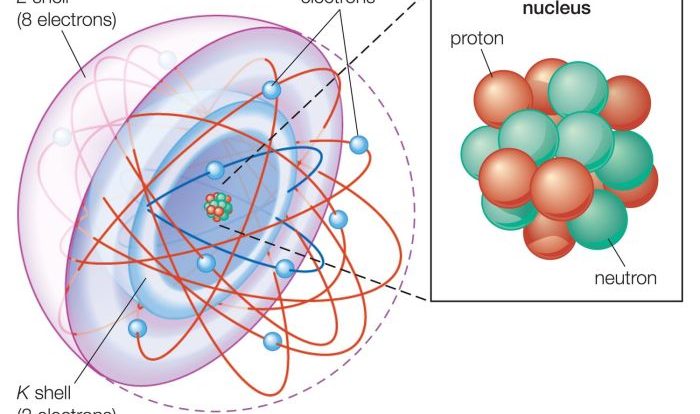Fossils science olympiad practice test – Prepare for triumph in the Fossils Science Olympiad with this comprehensive practice test. Immerse yourself in the captivating realm of paleontology, unearthing the secrets of ancient life through an engaging journey that will ignite your curiosity and expand your knowledge.
Embark on a scientific expedition, traversing the vast expanse of Earth’s history, from the formation of fossils to their significance in shaping our understanding of the planet’s past. Delve into the diverse types of fossils, unraveling their characteristics and composition.
Explore the methods used to analyze fossils, deciphering the behaviors and environments of extinct organisms.
Fossil Formation

Fossilization is the process by which the remains or traces of ancient organisms are preserved in the Earth’s crust. It occurs when organisms or their parts become buried and undergo a series of chemical and physical changes that transform them into fossils.
There are three main types of fossilization: permineralization, replacement, and carbonization. Permineralization occurs when minerals fill the spaces within an organism’s body, gradually replacing the organic matter. Replacement occurs when the original material of an organism is gradually dissolved and replaced by another mineral.
Carbonization occurs when the organic matter of an organism is converted into carbon, leaving behind a black or brown fossil.
The factors that affect fossil formation include the type of organism, the environment in which it lived, and the conditions after its death. Organisms with hard parts, such as bones, shells, or teeth, are more likely to be fossilized than soft-bodied organisms.
Organisms that lived in environments that are conducive to fossilization, such as swamps or lakes, are more likely to be fossilized than organisms that lived in environments that are not conducive to fossilization, such as deserts or oceans.
Types of Fossils
Fossils can be classified into different types based on their composition.
- Body fossilsare the preserved remains of an organism’s body, such as bones, shells, or leaves.
- Trace fossilsare evidence of an organism’s activity, such as footprints, burrows, or nests.
- Chemical fossilsare the preserved chemical compounds that were produced by an organism, such as lipids, proteins, or DNA.
Each type of fossil provides different information about the organism that produced it. Body fossils provide information about the organism’s anatomy and morphology. Trace fossils provide information about the organism’s behavior and ecology. Chemical fossils provide information about the organism’s biochemistry and genetics.
Fossil Record
The fossil record is the collection of all fossils that have been found. It provides a valuable record of the history of life on Earth.
Fossils help scientists determine the age of rock layers. By studying the fossils found in a particular rock layer, scientists can determine the relative age of that rock layer. The fossil record also helps scientists determine the absolute age of rock layers.
By using radioactive dating techniques, scientists can determine the age of the rock layers in which fossils are found.
The fossil record has contributed to our knowledge of past life in many ways. It has helped scientists to understand the evolution of life on Earth, the extinction of species, and the changes in the Earth’s environment over time.
Fossil Analysis

Fossils are analyzed by scientists to learn more about the organisms that produced them. Scientists use a variety of techniques to analyze fossils, including:
- Morphological analysisexamines the physical characteristics of a fossil, such as its size, shape, and structure.
- Chemical analysisexamines the chemical composition of a fossil, such as its elemental composition and isotopic ratios.
- Functional analysisexamines the function of a fossil, such as how it was used by the organism that produced it.
By analyzing fossils, scientists can infer the behavior and environment of ancient organisms. For example, by studying the teeth of a fossil, scientists can infer the diet of the organism that produced it. By studying the bones of a fossil, scientists can infer the locomotion of the organism that produced it.
Paleontology

Paleontology is the study of fossils. Paleontologists use fossils to learn about the history of life on Earth, the evolution of species, and the changes in the Earth’s environment over time.
Paleontology is divided into several subfields, including:
- Vertebrate paleontologystudies the fossils of vertebrates, such as mammals, birds, reptiles, amphibians, and fish.
- Invertebrate paleontologystudies the fossils of invertebrates, such as insects, mollusks, and crustaceans.
- Paleobotanystudies the fossils of plants.
- Micropaleontologystudies the fossils of microorganisms, such as bacteria and protists.
Paleontological research has led to many important discoveries about the history of life on Earth. For example, paleontologists have discovered that the Earth has been inhabited by life for at least 3.5 billion years. They have also discovered that the Earth has experienced several mass extinctions, which have wiped out a large percentage of the species that lived on Earth.
Quick FAQs: Fossils Science Olympiad Practice Test
What is the purpose of this practice test?
To prepare students for the Fossils Science Olympiad, enhancing their knowledge and skills in paleontology.
What topics are covered in the practice test?
Fossil formation, types of fossils, the fossil record, fossil analysis, paleontology, fossil preservation, fossil dating techniques, and fossils in society.
How can I use this practice test to improve my performance in the Science Olympiad?
By thoroughly completing the practice test, students can identify areas where they excel and areas that require further study, enabling them to focus their preparation accordingly.
